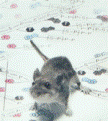Papers in the Biological Sciences

Jay F. Storz Publications
Document Type
Article
Date of this Version
5-1-2015
Citation
Am J Physiol Regul Integr Comp Physiol. 2015 May 1; 308(9): R779–R791.
Abstract
The hypoxic and cold environment at high altitudes requires that small mammals sustain high rates of O2 transport for exercise and thermogenesis while facing a diminished O2 availability. We used laboratory born and -raised deer mice (Peromyscus maniculatus) from highland and lowland populations to determine the interactive effects of ancestry and hypoxia acclimation on exercise performance. Maximal O2 consumption (VO2max ) during exercise in hypoxia increased after hypoxia acclimation (equivalent to the hypoxia at ~4,300 m elevation for 6–8 wk) and was consistently greater in highlanders than in lowlanders. V̇O2max during exercise in normoxia was not affected by ancestry or acclimation. Highlanders also had consistently greater capillarity, oxidative fiber density, and maximal activities of oxidative enzymes (cytochrome c oxidase and citrate synthase) in the gastrocnemius muscle, lower lactate dehydrogenase activity in the gastrocnemius, and greater cytochrome c oxidase activity in the diaphragm. Hypoxia acclimation did not affect any of these muscle traits. The unique gastrocnemius phenotype of highlanders was associated with higher mRNA and protein abundances of peroxisome proliferator-activated receptor γ (PPARγ). Vascular endothelial growth factor (VEGFA) transcript abundance was lower in highlanders, and hypoxia acclimation reduced the expression of numerous genes that regulate angiogenesis and energy metabolism, in contrast to the observed population differences in muscle phenotype. Lowlanders exhibited greater increases in blood hemoglobin content, hematocrit, and wet lung mass (but not dry lung mass) than highlanders after hypoxia acclimation. Genotypic adaptation to high altitude, therefore, improves exercise performance in hypoxia by mechanisms that are at least partially distinct from those underlying hypoxia acclimation.


Comments
Copyright © 2015 the American Physiological Society. Used by permission.